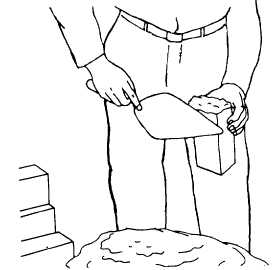Translations:Adventist Youth Honors Answer Book/Vocational/Masonry/48/en
Do not spread the mortar for a bed joint too far ahead of laying - four or five brick lengths is best. Mortar spread out too far ahead dries out before the bricks become bedded and causes a poor bond. The mortar must be soft and plastic so that the brick will bed in it easily. Spread the mortar about 1 inch thick and then make a shallow furrow in it (Figure 7, view 1). A furrow that is too deep leaves a gap between the mortar and the bedded brick. This reduces the resistance of the wall to water penetration. Using a smooth, even stroke, cut off any mortar projecting beyond the wall line with the edge of the trowel (view 2). Retain enough mortar on the trowel to butter the left end of the first brick you will lay in the fresh mortar. Throw the rest back on the mortar board. Pick up the first brick to be laid with your thumb on one side of the brick and your fingers on the other. Apply as much mortar as will stick to the end of the brick and then push it into place (Figure 8). Squeeze out the excess mortar at the head joint and at the sides. Make sure the mortar completely fills the head joint (Figure 9). After bedding the brick, cut off the excess mortar and use it to start the next end joint. Throw any surplus mortar back on the mortar board where it can be restored to workability.



